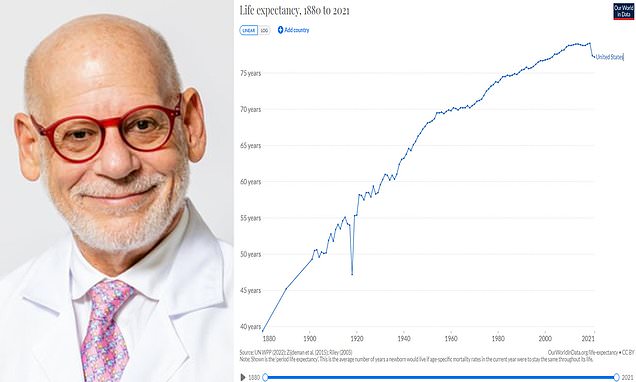The longevity guru claims that anyone reading this could realistically live to 150 thanks to leaps in technology.
Dr. Stephen Cohen, who owns wellness clinics in California and London, claims that people are getting intriguingly close to using stem cell therapy to prevent aging.
He argues that the technology to inject people with exosomes, tiny vesicles produced naturally by stem cells, could come true in just five years and revolutionize the anti-aging industry.
Other scientists have suggested that people could one day live to be 200 years old, and have found solutions such as pills to flush out “zombie cells” and ways to tweak DNA to extend someone’s lifespan. I am researching technology.
“The ability to prolong or delay aging sounds like science fiction, but it’s right there, and it will be readily available,” Dr. Cohen said.
“We have been a little hindered by the belief that humans must die someday and cannot live forever.
Stem cells have revolutionized the way we treat injuries, some cancers, and brain diseases due to their unique ability to repair and regenerate damaged tissue.
They are found throughout the body, especially in the bone marrow, ready to transform into over 200 types of cells that make up the human body to repair damage.
However, that number declines as we age, and older adults lack the same regenerative capacity as their younger peers.
This reduces the number of exosomes produced by stem cells, or tiny bubbles that migrate to damaged, old, or dying cells that carry important proteins to help repair them.
Dr. Cohen described them as “jet planes” delivering aid packages to diseased cells taking off from an “aircraft carrier”, the stem cells.
Scientists argue that low levels of these in the body accelerate aging because cells are less able to repair themselves.
There is growing scientific evidence that increasing the number of exosomes puts the brakes on the aging process.
a paper published last year found that more exosomes in the body boosted brain function. another From the same year, they suggested that it could alleviate frailty and help someone live longer.
Doctors also associate having more exosomes with younger-looking skin.
Cohen’s new treatment, which he says could be available by 2028, involves injecting someone with exosomes produced by young stem cells.
The hope is that these bubbles bursting with essential proteins, lipids, nucleic acids, etc. will flow into the organs and help them “age”, allowing someone to live longer.
There are also suggestions that it can revitalize the skin and make someone look younger.
This procedure, when it becomes available, could cost hundreds of thousands of dollars per person.
It’s unclear how long that will last, how many injections someone will need, or how often they will need to return for refills.
“The reason is related to the youthful exosomes in young mice, which transfer protein packages to older mouse cells, thereby repairing them and making them more youthful,” Cohen said.
“The strategy is to do this kind of treatment when we are young and have more healthy stem cells that can release young exosomes into our tissues to curb the aging process.”
“The human body has exosomes that repair damaged tissue and are released from stem cells.
“Imagine a stem cell as an aircraft carrier,” says my partner Dr. Tunc Tiryaki.
So exosomes are jets that take off and deliver packets of some sort to their targets.
“Basically, when there’s a need from damaged, senescent, or dying cells, they send out a signal and in response, the stem cells create endosomes from their cell walls to help reduce inflammation. Collects necessary substances from healthy cells. Blood flow and repair.
“The endosomes are then sent back into the circulation as exosomes to supply damaged and dying cells to help.”
Dr. Cohen condemns most aesthetic treatments for aging, such as plastic surgery, saying that these simply “mask up” the inevitable signs of decline without actually doing anything in the cell to slow it down. rice field”.
For example, when fillers are added to make up for lost volume from the face, they only camouflage the process, so they have little effect on aging cells and tissues, he said.
Scientists have been saying for years that there is no reason why humans can’t live beyond their natural lifespan.
The oldest known person is Jeanne Calment, a Frenchwoman who sold canvases to a young Vincent van Gogh in the late 1800s, who lived to be 122 and died in 1997.
One area of particular promise is the development of drugs to eliminate ‘zombie cells’ in the body, thought to be the main cause of tissue and organ decay.
These cells, like other cells, stop dividing, but begin spewing out a cocktail of toxic chemicals that damage and degrade the cells around them.
These flushing tablets are already in clinical trials and scientists say they could hit the market in just a decade.
Another way to combat aging is to study the DNA of reptiles and poikilotherms.
Michigan State University experts have begun studying dozens of reptile and amphibian species, including alligators and salamanders, to uncover genetic “signatures” that could target humans.
Some experts say that eradicating major causes of death such as cancer, dementia and heart disease could extend life even further.

